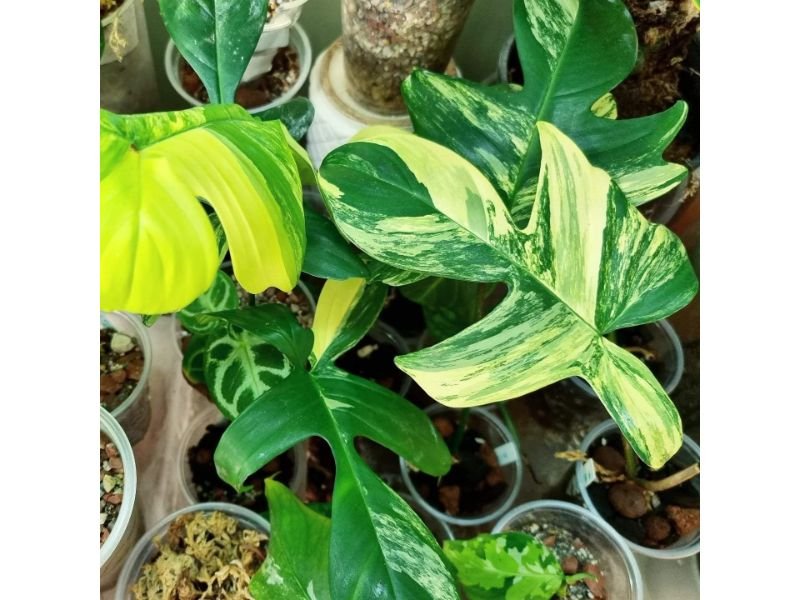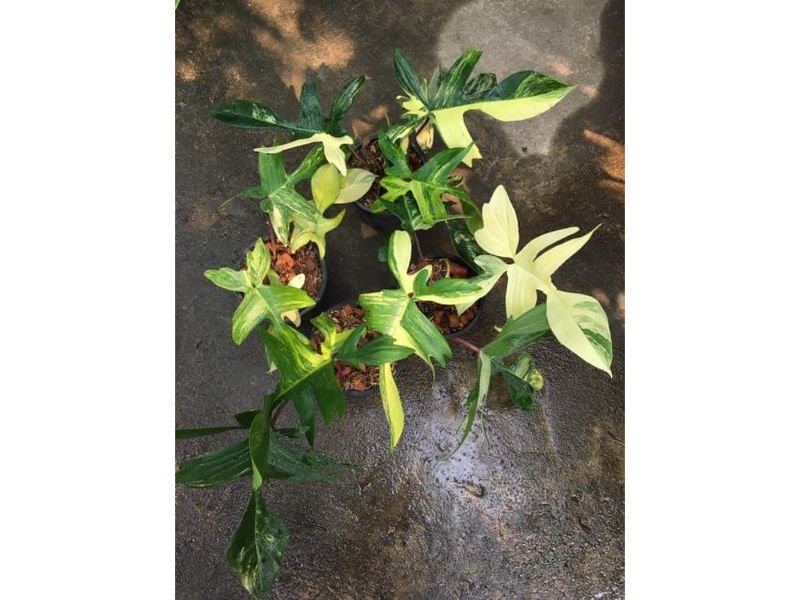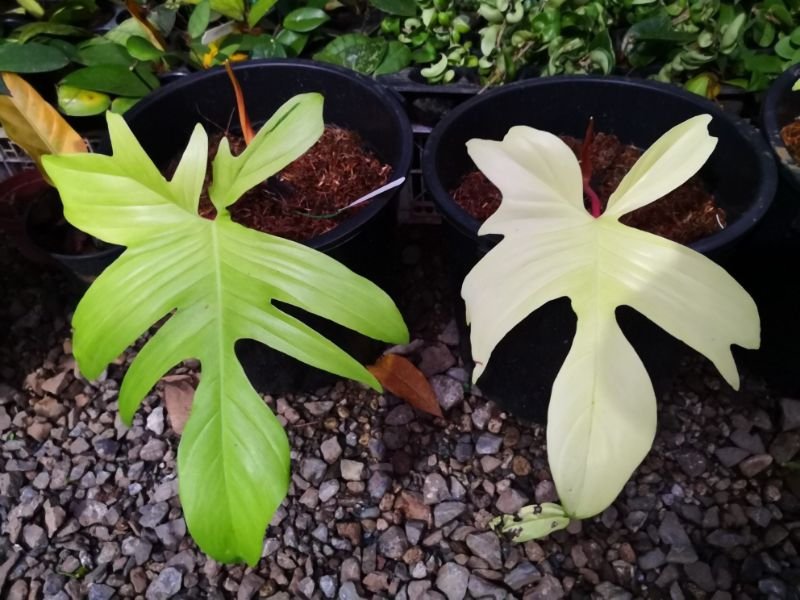With more than 400 cultivated species of philodendrons out there, it could be quite tricky to differentiate one philodendron cultivar from others. The two prominent cultivars that also often get people confused are Philodendron Florida Ghost and Philodendron Florida Beauty. But how to distinguish the two beauties and avoid buying the wrong one? In this section, we will guide you to explore the differences as well as similarities between Philodendron Florida Ghost vs Florida Beauty. Let’s check this out!
Table of Contents
Philodendron Florida Ghost vs Beauty: Key Differences

Common Name
The first and foremost thing to help you distinguish the two philodendron cultivars is their name. Both Philodendron Florida Ghost and Philodendron Florida Beauty are hybrid species of squamiferum and pedatum, but they are marketed as two different plants. While Philodendron Florida Ghost is known as it is, Philodendron Florida Beauty has one more ‘nickname’, that is Philodendron Magic Mask.
Foliage Color
The most outstanding feature between Philodendron Florida Ghost vs Florida Beauty is their foliage color. The two aroids both have ‘ghost’-shaped shiny foliage, but Philodendron Florida Ghost is notable for their lime or milky greenish-white color that is marked all over the foliage and will get darker as they mature. Meanwhile, Philodendron Florida Beauty is a color combination of dark green and milky greenish-white color that could be in split-half or splashed pattern.
Plant Height
Generally speaking, when it comes to height differences between the Philodendron Florida Ghost vs Florida Beauty, the Florida Ghost plant can reach about 60 to 152 centimeters (2 to 5 feet), with a maximum of 3 meters (12 feet) in height. Its relative, the Florida Beauty plant, is much taller in size where it can reaching a height of 27 meters (90 feet). When kept as an indoor decorative plant, both the Florida Ghost plant and Florida Beauty plant can be pruned to reduce their massive size.
Country of Origin
Philodendron Florida Beauty was first produced in Florida during the 1950s by a botanist named Robert McColley during his breeding program. Together with his colleagues, he also found another cultivated philodendron species which was named after him, the Philodendron McColley Finale. Nonetheless, the origin of the Philodendron Florida Ghost is rather unknown.
Philodendron Florida Beauty vs Ghost: Major Similarities
Growing Zones and Blooming Time


Both of the aroids’ native environment is the humid and warm tropical rainforests. As such, they thrive well in zones 9 to 11 with the usual blooming time around spring and summer. Nevertheless, Philodendron Florida Beauty and Philodendron Florida Ghost grow well too in growing zones under 9 and above 12, with the exception to grow as indoor plants. A minimum temperature of 18 celsius is what the two plants love, and anything above 13 celsius is too cold for these gorgeous beauties.
Light
As tropical enchantress who spends most of their life under high trees and canopies, both Philodendron Florida Ghost vs Florida Beauty can not tolerate direct full sun as it will burn their delicate foliage. The bright, indirect light as in the east-facing windows is the best-growing area to place them.
Soil
One of the advantages of having aroids is the ease of finding a perfect soil mix. All kinds of aroid potting mixes are fine for both Philodendron Florida Ghost and Philodendron Florida Beauty. But take note that the soil should provide good drainage as well as well aeration, which the two plants will thank you for. Usual ingredients such as orchid bark, perlite, and coco peat are the most used in the aroid soil mix.
Water
When it comes to watering, the Philodendron Florida Ghost vs Florida Beauty shares similarities. They don’t like too-soaky, watery soil, but prefer moist soil with regular and minimum watering once a week. About 1 inch or 2.5 centimeters of the topsoil is where you should water these two. However, do not let their soil completely dry.
Humidity
The nature of tropical rainforests is very high in humidity, therefore these two cultivated aroids love high humidity too! Both Philodendron Florida Beauty and Philodendron Florida Ghost prefer areas with 50% to 70% humidity, where higher is better.
Dormancy
As descendants of tropical plants, the two Philodendron Florida Ghost vs Florida Beauty can go into dormancy (hibernation in plants) when the temperature becomes too cold. But worry not, after the cold season passes, these two will ‘wake up’ and bloom as usual. Just make sure the temperature goes back to normal, with a minimum of 18 celsius. When it comes to aroids, the warmer temperature is for the win!
Fertilizers
One more trump card in the case of growing both Philodendron Florida Ghost and Philodendron Florida Beauty is how easy it is to find their matching fertilizers. Philodendron Florida Ghost prefers a nitrogen-rich fertilizer, the very same can be used too for Philodendron Florida Beauty. Aside from the basic NPK (nitrogen, phosphorus, and potassium) fertilizer, you can boost their growth by using organic fertilizers too.
Repotting and Pruning

Repotting and pruning are essential steps when it comes to gardening. Fortunately, the repotting and pruning process is not difficult when it comes to maintaining Philodendron Florida Ghost vs Florida Beauty. Repotting should be done in early spring or before the plants dive into their growing phase, to provide more room for younger plants to grow and to prevent root binding.
Pruning is not only beneficial to make the Florida Ghost and the Florida Beauty plant grow to your desired height, but also for the plant’s overall health. When to do pruning, usually in summer for these two, do not forget to remove any diseased, dead, yellowing, and dried stems and foliage. Use sterile cutting shears, snap-cut pruners, or pruning saws to help you with the pruning process.
Toxicity and Rareness

You might be a little surprised by the fact that these two both contain calcium oxalates–which are harmful to humans and pets if ingested in high quantities. Despite their toxicity, the Florida Ghost plant and the Florida Beauty plant are still occupying most gardeners’ hearts for their unique foliage shape and color, as well as their scarcity that sometimes, will cost you a lot of cash.
Pests and Diseases
Common pests like aphids, mealybugs, spider mites, and bacterial leaf spots caused by Xanthomonas, along with common diseases like yellowing and browning leaves, root rot, and stunted growth are the culprits than can cause major sickness for the Florida Ghost plant and the Florida Beauty plant. By analyzing what caused the plant’s illness, you can cure these two delicate foliage plants using insecticide, horticultural oil, and neem oil, or by reducing the amount of watering and fertilizing.
Wrapping Up: Philodendron Florida Ghost vs Florida Beauty Differences and Similarities
To conclude, the most prominent differences between Philodendron Florida Ghost vs Florida Beauty are in their foliage color, size, common name, and back story. They do have more similarities as being easy to take care of plants that do not require much watering, love most and good drainage soil, and thrive well only under bright, indirect light. After the above discussion, we hope to identify which one is the Philodendron Florida Ghost and which one is the Florida Beauty is now easier than ever.

New author in the hood. Loves gardening and flowers are my spirit animals (yes I know they are not animals but I insist). I will be covering most of the flowers’ topics here and occasionally random though as well.






